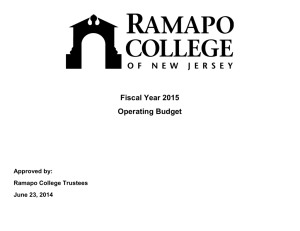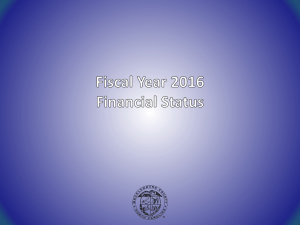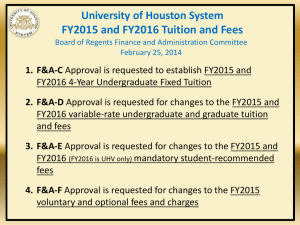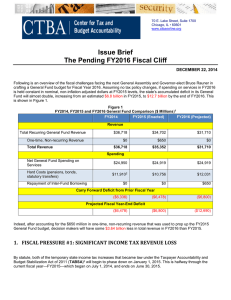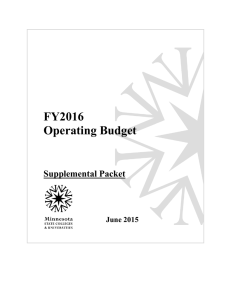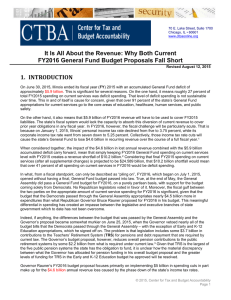Fiscal Year 2016 Operating Budget Approved by:
advertisement
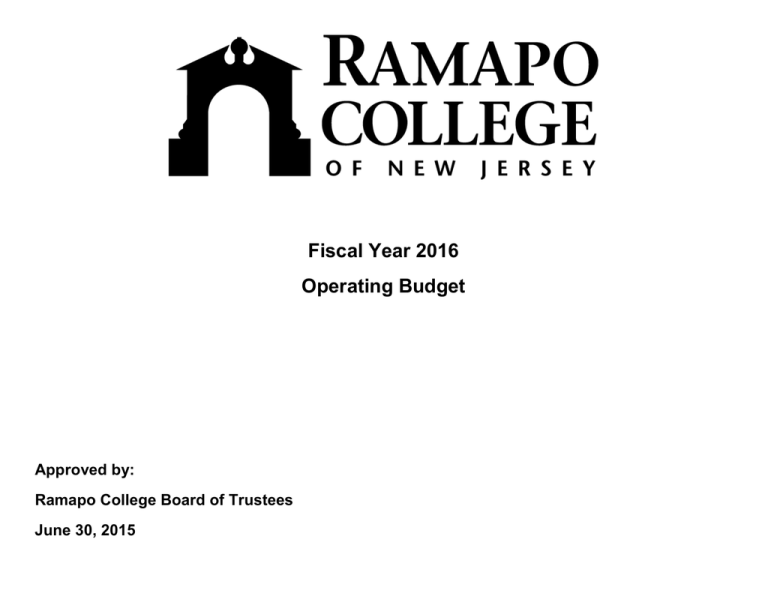
Fiscal Year 2016 Operating Budget Approved by: Ramapo College Board of Trustees June 30, 2015 Board of Trustees George C. Ruotolo, Jr. Chair William F. Dator Vice Chair David G. Schlussel Secretary Josef Weikl Student Trustee Vincent Colman Peter McBride Gary L. Montroy A.J. Sabath Charles H. Shotmeyer Bartholomew J. Talamini Susan A. Vallario Sharlene S. Vichness Thomas A. Zelante, Esq. President Peter P. Mercer Executive Summary This executive summary provides a brief overview of Ramapo College’s operating plan and projected sources and expenditures of funds for the fiscal year beginning July 1, 2015 and ending June 30, 2016. The operating budget was developed to support the vision of Ramapo College and is aligned with its Strategic Plan. As the College continues to link the budget process to planning, the administration remains committed to managing resources effectively. As costs have risen over the past year direct state support has decreased. The College will persist in its efforts to carefully review expenditures and reallocate resources where necessary in order to meet its strategic planning goals. Throughout the year, budgets are monitored to ensure that expenditures do not exceed authorized amounts and are used for intended purposes. The College maintains an online budgetary control system (Ellucian Banner) to assist unit directors with the management of their accounts. Approval of the budget and setting of tuition and fees is ratified by the Ramapo College Board of Trustees who constitute authority for the administration to expend funds within the total dollar limit of the approved budget. The Fiscal 2016 Budget The operating budget of $155.4 million is an increase of $2.8 million over FY2015, which represents a 1.8% increase. Additional cost factors include projected increases in bargaining unit contracts and higher employee fringe benefit expenses. The Administration continues to effectively adjust spending in order to balance the budget and keep tuition and fee increases at a reasonable level. The Board of Trustees approved a 2.5% increase in tuition and fees, housing and board charges. The overall increase will be $600 for a full time NJ residential student and $816 for an out-of-state student. Ramapo’s base state appropriation of $14.6M is a reduction of $1.5M or 9.25% from FY2015. The additional revenue in state fringe benefits of $672,000 is offset by an increase to the fringe benefits expense. In FY2016, state support will fund approximately 27.3% of our total operating budget, while student tuition and fees funds approximately 44.7%. Other assumptions that were incorporated into the FY2016 base operating budget include: • • • • • Tuition and fee increase of 2.5% Housing and board increase of 2.5% Salary step / increments for union employees projected at 1% Funding for top priorities to meet our strategic planning initiatives Inflationary increases The following pages provide some of the highlights of the FY2016 operating budget. Where the Money Comes From Ramapo’s operating budget has five (5) major sources of funding. Sources of FY2016 Revenues Auxiliary 26.5% • State appropriation – includes direct state support and state funded fringe benefits State Support 27.3% • Net tuition • Fees • Auxiliary – self-supporting activities that includes student housing charges, meal plan, bookstore, student activity and student center fees • Other sources – includes interest income and other miscellaneous sources Other 1.5% Fees 13.1% Net Tuition 31.6% Revenue Budget Summary FY2015 vs. FY2016 ($) in Millions FY2015 FY2016 Amt Diff. % Diff Educational & General Revenues Direct State Appropriation $ 16,130 $ 14,638 $ (1,492) -9.2% State Funded Fringe Benefits $ 27,145 $ 27,817 $ 672 2.5% Net Tuition $ 46,804 $ 49,019 $ 2,215 4.7% Student Fees $ 19,550 $ 20,348 $ 798 4.1% Other Sources $ 2,381 $ 2,223 $ (158) -6.6% Interest Income $ 200 $ 100 $ (100) -50.0% Total Educational & General Revenues $ 112,210 $ 114,145 $ 1,935 1.7% Auxiliary Services $ 41,218 $ 829 2.1% Total Revenue $ 152,599 $ 155,363 $ 2,764 1.8% 40,389 $ What the Operating Budget Funds Expenditures by Program Debt Service 11.2% Auxiliary Svcs 15.8% Expenditures by Category Instruction 32.6% Physical Plant 11.9% Institutional Support 14.3% Other 11.0% Academic Support 4.9% Debt Service 11.2% Contracted & Professional 9.3% Fuel & Utilities 3.3% Maintenance & Capital Improv. 2.8% Student Services 9.3% Salaries and Benefits 62.4% • 37.5% funds academic activities such as instruction, advising, and library. • Salaries and benefits make up the majority of the budget at 62.4%. • Debt makes up 11.2% of the operating budget. • The operating budget has very little discretionary non-fixed costs. • Other includes materials, supplies, and services. Expenditure Budget Summary FY2015 vs. FY2016 FY2016 FY2015 ($) in Millions Amt Diff. % Diff Educational & General Expenditures Instruction $ 49,449 $ 50,724 $ 1,275 2.6% Academic Support $ 7,326 $ 7,628 $ 302 4.1% Student Services $ 13,746 $ 14,277 $ 531 3.9% Institutional Support $ 22,011 $ 22,168 $ 157 0.7% Physical Plant $ 17,807 $ 18,459 $ 652 3.7% Financial Aid & Scholarships $ 205 $ 189 $ (16) -7.8% Total Educational & General Expenditures $ 110,544 $ 113,445 $ Auxiliary Expenditures $ 24,675 $ 24,559 $ (116) -0.5% Debt Service-Educational & General $ 8,122 $ 7,960 $ (162) -2.0% Debt Service-Auxiliary $ 9,258 $ 9,399 $ 141 1.5% Total Debt Service Expenditures $ 17,380 $ 17,359 $ (21) -0.1% Total Expenditures $ 152,599 $ 155,363 $ 2,901 2,764 2.6% 1.8% Cost Saving Initiatives • The College has been able to contain costs, reduce expenditures, and reallocate resources. • Cost containment is vital to our budget process for future strategic investments. • Debt reduction due to defeasance of bonds. • Other cost savings initiatives: a. utility costs reduction b. salary elimination/ defer hiring c. across the board non salary cuts d. other expenses (SPIF, reserves) Tuition and Fees The FY2016 budget is based on the annualized undergraduate tuition and fee rates. FY2015 Rate FY2016 Rate $ Increase % Increase In-State Tuition Fees Capital Improvements Fee Sub Total $ $ $ $ 8,650 3,738 1,000 13,388 $ $ $ $ 8,866 3,832 1,000 13,698 $ $ $ $ 216 94 310 2.5% 2.5% 0.0% 2.3% Housing (Pine ) Board (Ultimate Plan) $ $ 8,020 3,530 $ $ 8,221 3,620 $ $ 201 90 2.5% 2.6% Total In-State Resident $ 24,938 $ 25,538 $ 600 2.5% Out-of-State Tuition Fees Capital Improvements Fee Sub Total $ $ $ $ 17,300 3,738 1,000 22,038 $ $ $ $ 17,731 3,832 1,000 22,563 $ $ $ $ 431 94 525 2.5% 2.5% 0.0% 2.4% Housing (Mackin Triple) Board (Super 14 Plan) $ $ 8,020 3,530 $ $ 8,221 3,620 $ $ 201 90 2.5% 2.6% Total Out-of-State Resident $ 33,588 $ 34,404 $ 816 2.5%
